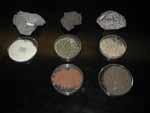Home | Session 4 | Product of Weathering Pg 1, 2, 3, 4
The Products of Weathering and Erosion
Presented
by Lisa White
San Francisco State University
-
Closely observe the various rocks and sediment samples on display and see if you can match the rocks with the sand-sized material and the soil.

Questions to answer:
-
How closely does the parent material match the weathering product? Does the sediment always look exactly like source rock? Why or why not?
-
What series of processes occur to generate sand and clay that changes the physical appearance of the material?
Answer: The process of weathering mechanically breaks down the rocks to fragments of various sizes and shapes. The material initially produced during weathering will be smaller fragments of the parent rock and will look much like the source. After a series of weathering cycles, sand-sized material will be produced and the grains continue to reflect the parent rocks. After many generations, particularly of extensive chemical weathering that operates on long time scales, the rock is worn-down to clay minerals that are physically and chemically different from the parent rock . Visually, they will appear to not as closely match the materials produced during early generations of weathering.
-
updated March 6, 2002
UCMP Home | What's new | About UCMP | History of Life | Collections | Subway